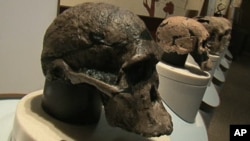Scientists writing in the journal Science report that two skeletons found in a cave in South Africa belong to a previously unclassified species of hominid or early human relative. This discovery may shed new light on the evolution of our own species, homo sapien, and spark greater interest in human evolution. So may a new exhibition at the Smithsonian Institution's Natural Museum of Natural History. It's based on developments of more than a century of scientific research.
The National Museum of Natural History is marking its 100th anniversary by welcoming visitors to its newest hall.
They're here to explore the age-old question: "What does it mean to be human?"
Curator Rick Potts says the 300 fossils and other artifacts on display illustrate a mosaic of physical traits and behaviors that evolved over time.
"And all of those species are now gone, their ways of life no longer on earth," said Potts. "We are the only ones left of the diverse family tree."
Visitors peer into the eyes of replicas of early humans, sit down at their ancestral hearth and walk in footprints molded from those left almost 4 million years ago in Tanzania.
"And those footprints are exactly at the spacing, the size of the footprints, where three individuals walked across an African plain that long ago," added Potts.
Two prized fossils are in this case. One is the 28,000 year-old skull of a Cro-Magnon, the first modern humans in Europe. The other is the skull of a Neanderthal, a species of upright primates that co-existed with Cro-Magnon until they disappeared about 30,000 years ago.
Both skulls are on loan from the Musee de l'Homme in Paris. They were discovered in France around the same time that Charles Darwin published his famous "On the Origin of Species" in 1859.
Alain Froment, who curates the French museum's anthropology collection, says Darwin's work played a crucial role.
"It fueled the debate on the origin of mankind and the surprise was to find such a modern human in the fossil context with extinct animals," said Froment.
Visitors are invited to touch the ancestral replicas, to transform an image of their face into an early-human version and to engage with dioramas that convey evolution.
This six-million-year-old story also unfolds during an era of dramatic climate change. Rick Potts says the exhibit shows how, during great swings between warm and cool, moist and dry, humans adapted.
"Not only adapted to an African savannah or how Neanderthals became adapted to an ice age, but rather how our ability to make tools, our ability to have an expanded and complex brain, even our ability to use symbols and speak to one another, are not just adaptations to a past ancestral environment, but an adaptation to being flexible, to being adaptable," explained Potts.
Elementary school teacher Neisha Speights-Burno plans to share that lesson with her students.
"I think it just gives them more of a first-hand account that this stuff really did exist," noted Speights-Burno.
The sense of connection is important for Charla Weiswurm visiting Washington from Texas.
"I think that with all the conflict with everyone in the world, that you come back saying we all came from the same place originally, and why can't we just all get along because we are all exactly alike," said Weiswurm.
Rick Potts hopes the exhibit answers that question by showing that our ancient relatives are worth getting to know. And in knowing them, he adds, they can teach us what it means to be human.












